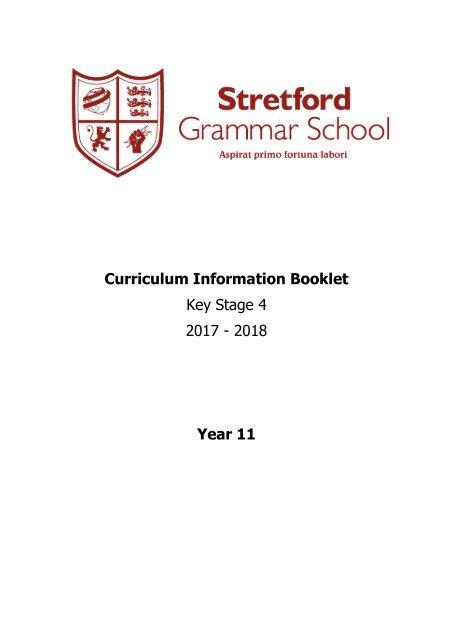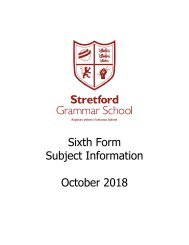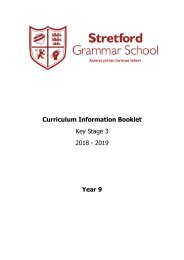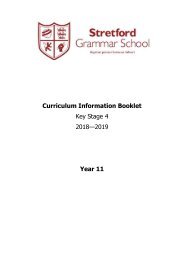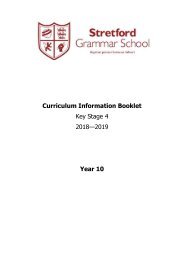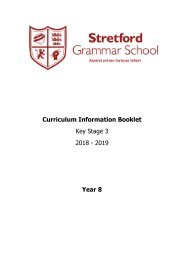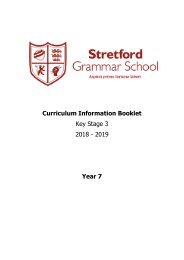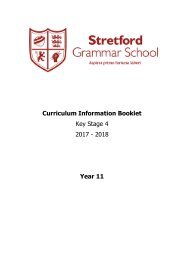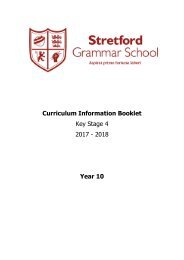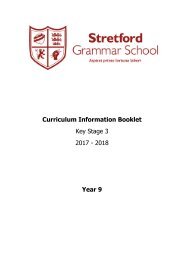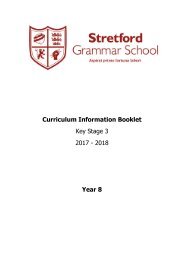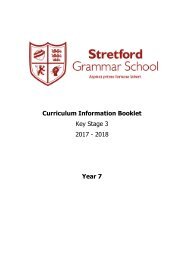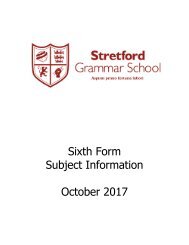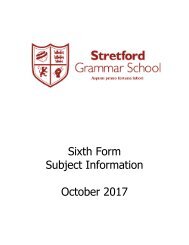Year 11 Curriculum Information Booklet 2017-2018
Create successful ePaper yourself
Turn your PDF publications into a flip-book with our unique Google optimized e-Paper software.
<strong>Curriculum</strong> <strong>Information</strong> <strong>Booklet</strong><br />
Key Stage 4<br />
<strong>2017</strong> - <strong>2018</strong><br />
<strong>Year</strong> <strong>11</strong>
Vision and Values<br />
Aspirat primo fortuna labori<br />
Fortune smiles on our first effort<br />
At the heart of the school’s ethos is the ambition that every student has the<br />
opportunity to experience success. Whether in sport, enrichment or the curriculum,<br />
students will develop their self-confidence and employability through:<br />
a. A school community which is committed to development of staff and students by<br />
embracing leadership opportunities<br />
b. Making maximum progress as a result of consistently high standards of teaching<br />
and learning<br />
c. A curriculum which provides all students with the skills and knowledge to facilitate<br />
a love of lifelong learning and the motivation to realise their potential as active<br />
citizens in an ever changing world<br />
d. Facilities designed and planned to meet the needs of the school community and<br />
provide opportunities to enrich and enhance learning<br />
e. The development of an extended school, working in partnership to meet the<br />
needs of the wider community<br />
Therefore, at Stretford Grammar School we believe:<br />
<br />
<br />
<br />
<br />
<br />
<br />
In the pursuit of academic excellence<br />
In having high expectations of the progress of our students<br />
That we learn best in an environment where success in all its forms is<br />
celebrated and everyone is encouraged to take personal responsibility<br />
That this environment is created through clearly stated expectations of<br />
behaviour with emphasis on discipline and appropriate rewards<br />
That everyone needs to experience success in some aspect of school life<br />
to gain confidence and raise self esteem<br />
That we are all members of a learning community built on mutual respect<br />
and support
Calendar of Events for <strong>Year</strong> <strong>11</strong><br />
<strong>11</strong> th September 3.30 pm – 4.30 pm Parent Drop In<br />
26 th September <strong>2017</strong> European Day of Languages<br />
2 nd October <strong>2017</strong> GCSE Preparation and <strong>Information</strong> Evening<br />
3 rd October <strong>2017</strong> GCSE Skills Day<br />
5 th October <strong>2017</strong> <strong>Year</strong> <strong>11</strong> Theatre Visit – The Lowry<br />
12 th October <strong>2017</strong> Sixth Form Open Evening<br />
23 rd October – 27 th October Half Term<br />
8 th November Iceland Meeting<br />
13 th November – 24 th November <strong>2017</strong> <strong>Year</strong> <strong>11</strong> Mock Examination<br />
1 st December – 2 nd December French Christmas Market Visit<br />
6 th December 7.00 pm Christmas Concert<br />
12 th December SEND Parent Forum<br />
20 th December <strong>2017</strong> Mock Results Day<br />
22 nd December School Closes for Christmas<br />
8 th January School Reopens<br />
24 th January <strong>Year</strong> <strong>11</strong> Parents’ Evening<br />
25 th January <strong>2018</strong> Taster Day<br />
1 st February Intermediate Maths Challenge<br />
12 th – 16 th February Visit to Iceland<br />
12 th – 16 th February Half Term<br />
20 th March SEND Forum<br />
29 th March School Closes for Easter<br />
16 th April School Reopens<br />
2 nd May Spring Concert<br />
14 th May <strong>2018</strong> GCSE Begin<br />
23 rd May – 29 th May Barcelona Visit<br />
28 th May – 1 st June Half Term
About our curriculum<br />
All students at Stretford Grammar School follow a broad and balanced curriculum. The<br />
curriculum is designed to engage and challenge all students to thrive to achieve their full<br />
potential, both in their studies and in developing as young people equipped to live happy and<br />
fulfilling lives in modern Britain and beyond. We aim to develop confident, considerate and<br />
successful young people, who enjoy and appreciate the value of learning and citizenship,<br />
ready to make a positive contribution to their local communities and to society.<br />
Students’ social, moral, spiritual, cultural and physical development at Stretford Grammar<br />
School is essential to their development as young people. All curriculum areas contribute to<br />
this programme, alongside specialist provision within Religious Education and through the<br />
Personal, Social, Health and Citizenship Education (PSHCE) programme which focusses on the<br />
areas of sex and relationships, careers, health, democracy, the rule of law, individual liberty<br />
and mutual respect and tolerance of those with different faiths and beliefs.<br />
Students will follow a core curriculum: English Language GCSE, English Literature GCSE,<br />
Mathematics GCSE, a Humanities GCSE – Geography or History GCSE, Religious Studies GCSE<br />
and non-examined courses in PSHCE and Physical Education.<br />
There is also the option to choose three further subjects for GCSE: Art, Business Studies,<br />
Computing, Food Production and Nutrition, French, Geography, History, Music, Physical<br />
Education, Product Design, Psychology, Spanish and Triple Science (* if students do not<br />
choose Triple Science they will be required to study Dual Science).<br />
The school does not preclude any student from attaining an English Baccalaureate (EBacc)<br />
suite of qualifications given the choices available.
Assessment and Reporting<br />
The purpose of assessment is to enable an informed judgement to be made about a<br />
student’s knowledge, understanding, skills and attitude. During your child’s academic career<br />
at Stretford Grammar School assessment is a continuous process which is integral to the<br />
teaching and learning cycle. For every subject your child will be assessed at various points<br />
throughout the year and these assessments will be used to inform you about the progress<br />
that your child is making in that subject area.<br />
During each term you will receive a data capture report that contains a working at grade<br />
(WAG), a target to improve sentence and an attitude to learning grade. The WAG indicates<br />
the current level of attainment at the point in time of the report. This grade is based on the<br />
formative assessments that take place during the year.<br />
The WAG reflects the new grading system that has been introduced at GCSE. The 1-9<br />
grading system is used through Key Stage 3 and Key Stage 4. Each grade reflects a set of<br />
skills and knowledge that are specified for each subject area. Below is the expected flight<br />
path of academic progression that your child will be tracked against.<br />
<strong>Year</strong><br />
Group<br />
Progression Flight Path<br />
<strong>11</strong><br />
10<br />
9<br />
8<br />
7<br />
Grade 1 2 3 4 5 6 7 8 9<br />
Old Grade G F E D C B A A* A* +<br />
The Working At Grade will reflect whether a student is making progress at a level that is at<br />
the top of a grade skill descriptors (+), making the expected progress within the grade skill<br />
descriptors (=), or making progress that is at the beginning of the grade skill descriptors (-).<br />
The target to improve sentences will provide your child with specific advice on how to make<br />
further progress. The attitude to learning grade reflects your child’s approach to their studies.<br />
<br />
Assessment should be based on clear, consistent criteria which are known and<br />
understood by both teachers, students and parents/carers, and are guided by<br />
national criteria and statutory requirements where appropriate.
In order to achieve consistency, assessment practice should be subject to effective<br />
moderation and standardising procedures, including regular work scrutinies, learning<br />
walks and departmental Quality Assurance.<br />
A wide range of assessment techniques should be used in different contexts and for<br />
different purposes.<br />
Assessment should provide opportunities for effective differentiation to take place.<br />
Assessment should be supported by a wide range of evidence collected over a period<br />
of time which provides a fair and thorough representation of students' skills,<br />
knowledge and understanding.<br />
Students should be involved in the assessment process so that they are encouraged<br />
to take responsibility for their own learning.<br />
The assessment process should recognise achievement, not just attainment, and<br />
seek to increase students' confidence and motivation.<br />
Assessment should support individuals in identifying strengths and weaknesses,<br />
enabling future learning to be planned through targets to improve, and assisting<br />
them in decision-making.<br />
Assessment practice should be monitored regularly and systematically and<br />
assessment procedures modified if necessary as a result.<br />
The results of assessment should be systematically recorded and used to report to<br />
parents/carers on their children's attainment.
Art<br />
Unit 1 – Knowledge, Understanding<br />
and Skills<br />
Students will explore and create work<br />
associated with areas of study from at least<br />
two of the following:<br />
<br />
<br />
<br />
<br />
Fine art<br />
Graphic Communication<br />
Textile Design<br />
3-D Design<br />
Unit 2 – Fine Art Drawing<br />
Painting<br />
Sculpture<br />
Print Making<br />
Mixed Media<br />
Unit 3 – Graphic Communication Graphics<br />
Design<br />
Advertising<br />
Branding<br />
Illustration<br />
Interactive Design<br />
Motion Graphics<br />
Unit 4 – Textile Design Art textiles<br />
Fashion Design<br />
Costume Design<br />
Constructed Textiles<br />
Printed Textiles<br />
Unit 5 – 3D Design Architectural Design<br />
Sculpture<br />
Ceramics<br />
Product Design<br />
Jewellery<br />
Interior Design<br />
3d Design<br />
Additional <strong>Information</strong><br />
Mr. C. Lea – <strong>Curriculum</strong> Leader for Art<br />
art@stretfordgrammar.com
Biology<br />
The <strong>Year</strong> 10 course continues from where students finished at the end of <strong>Year</strong> 9.<br />
Unit 1 : Organising animals and plants<br />
(part 2)<br />
Unit 2 : Communicable diseases<br />
Students will study the following:<br />
Tissues and organs in plants<br />
Transport systems in plants<br />
Evaporation and transpiration<br />
Factors effecting transpiration<br />
Students will study the following:<br />
<br />
<br />
<br />
<br />
<br />
<br />
<br />
<br />
<br />
<br />
<br />
<br />
Health and disease<br />
Pathogens and disease<br />
Growing bacteria in a lab<br />
Preventing bacterial growth<br />
REQUIRED PRACTICAL: The<br />
effects of antiseptics or<br />
antibiotics on bacterial growth<br />
Preventing infections<br />
Viral diseases<br />
Bacterial diseases<br />
Diseases caused by fungi and<br />
protists<br />
Human defence responses<br />
More about plant diseases<br />
Plant defence responses<br />
Unit 3 : Preventing and treating<br />
disease<br />
Unit 4 : Non communicable diseases<br />
Students will study the following:<br />
Vaccination<br />
Antibiotics and painkillers<br />
Discovering drugs<br />
Developing drugs<br />
Making use of monoclonal<br />
antibodies<br />
Uses of monoclonal antibodies<br />
Students will study the following:<br />
<br />
<br />
<br />
<br />
<br />
Non- communicable diseases<br />
Cancer<br />
Smoking and the risk of disease<br />
Diet, exercise and disease<br />
Alcohol and other carcinogens
Unit 5 : Photosynthesis<br />
Students will study the following:<br />
<br />
<br />
<br />
<br />
<br />
Photosynthesis<br />
The rate of photosynthesis<br />
REQUIRED PRACTICAL:<br />
INVESTIGATING THE RATE OF<br />
PHOTOSYNTHESIS<br />
How plants use glucose<br />
Making the most of photosynthesis<br />
Unit 6 : Respiration<br />
Students will study the following:<br />
<br />
<br />
<br />
<br />
Aerobic respiration<br />
The response to exercise<br />
Anaerobic respiration<br />
Metabolism and the liver<br />
Unit 7 : The Nervous System<br />
Students will study the following:<br />
<br />
<br />
<br />
<br />
<br />
<br />
<br />
Principles of homeostasis<br />
The structure and function of the<br />
nervous system<br />
Reflex actions<br />
REQUIRED PRACTICAL:<br />
INVESTIGATING REACTION TIMES<br />
The brain<br />
The eye<br />
Common problems of the eye<br />
Unit 8 : Hormonal control<br />
Students will study the following:<br />
<br />
<br />
<br />
<br />
<br />
<br />
<br />
<br />
<br />
<br />
<br />
Principles of hormonal control<br />
The control of blood glucose levels<br />
Treating diabetes<br />
The role of negative feedback<br />
Human reproduction<br />
Hormones and the menstrual cycle<br />
The artificial control of fertility<br />
Infertility treatments<br />
Plant hormones and responses<br />
Using plant hormones<br />
REQUIRED PRACTICAL: THE<br />
EFFECT OF LIGHT OR GRAVITY<br />
ON SEED GROWTH
Unit 9 : Homeostasis in action<br />
Students will study the following:<br />
<br />
<br />
<br />
<br />
Controlling body temperature<br />
Removing waste products<br />
Dialysis – an artificial kidney<br />
Kidney transplants<br />
Additional <strong>Information</strong><br />
Mrs. G. Sutton – <strong>Curriculum</strong> Leader for Science / Biology<br />
Biology@stretfordgrammar.com
Business<br />
Unit 1 – Business in the<br />
Real World<br />
Students will study the following:<br />
<br />
<br />
<br />
<br />
<br />
<br />
<br />
<br />
<br />
<br />
<br />
<br />
<br />
<br />
<br />
<br />
<br />
<br />
<br />
Purpose of business<br />
Reasons for starting a business<br />
Basic functions and types of business<br />
Business enterprise and entrepreneurship<br />
Dynamic nature of business<br />
Sole traders<br />
Partnerships<br />
Private limited companies (ltd)<br />
Public limited companies (plc)<br />
Not-for-profit organisations<br />
What are business aims and objectives?<br />
Purpose of setting objectives<br />
Role of objectives in running a business<br />
Changing objectives<br />
Use of objectives in judging success<br />
Main stakeholders of businesses<br />
Objectives of stakeholders<br />
Impact of business activity on stakeholders<br />
Impact and influence stakeholders have on<br />
businesses<br />
Unit 2 – Business<br />
Operations<br />
<br />
<br />
<br />
<br />
<br />
<br />
<br />
<br />
<br />
<br />
<br />
<br />
<br />
Methods of Production – job, flow<br />
Efficiency in Production – lean production, just in<br />
time<br />
Managing Stock<br />
Factors Affecting Choice of Supplier<br />
The Effects of Procurement and logistics and<br />
business<br />
The Value of Effective Supply Chain Management<br />
Consequences of quality issues<br />
Total Quality Management<br />
Costs and benefits of maintaining quality<br />
Methods of Good Service<br />
Benefits of Good Customer Service<br />
Dangers of Poor Customer Service<br />
The ways in which advances in ICT have allowed<br />
customer services to develop<br />
Unit 3 – Human Resources Organisational structures<br />
Centralisation and decentralisation
Methods of Recruitment and selection of<br />
employees<br />
Importance of motivation in the workforce<br />
Importance of training the workforce<br />
Unit 4 - Marketing The Importance of identifying and satisfying<br />
customer need<br />
Types of segmentation<br />
Purpose of Market Research<br />
Methods of Market Research<br />
The Use of Market Research<br />
Pricing Methods<br />
The Factors that Influence Pricing<br />
Product<br />
Promotional Materials<br />
E-commerce and M-commerce<br />
The Integrated Nature of the Marketing Mix<br />
<br />
Unit 5 - Finance Methods used to raise finance<br />
Appropriateness of the sources of finance<br />
Importance of cash to business<br />
The Difference between Cash and Profit<br />
Financial Terminology<br />
Break-Even<br />
Financial Statements<br />
Additional <strong>Information</strong><br />
Miss J. Platt– <strong>Curriculum</strong> Leader for Business and Economics<br />
business@stretfordgrammar.com
Chemistry<br />
The <strong>Year</strong> 10 course continues from where students finished at the end of <strong>Year</strong> 9.<br />
Unit 1 : Structure and Bonding and the<br />
properties of matter<br />
Unit 2: The Periodic Table<br />
Students will study the following:<br />
Metallic bonding<br />
Ionic bonding and structure<br />
Simple covalent molecules<br />
Giant covalent molecules<br />
Nanoparticles<br />
Ceramics and composites<br />
Students will study the following:<br />
Historical development of The<br />
Periodic Table<br />
Group 1<br />
Group 7<br />
The Noble gases<br />
The transition metals<br />
Unit 3 : Chemical Analysis<br />
Students will study the following:<br />
<br />
<br />
<br />
<br />
Formulations<br />
Identification of common gases<br />
Flame tests<br />
Tests for hydroxides, sulfates,<br />
halides and carbonates.<br />
Unit 4 : Organic Chemistry 1<br />
Students will study the following:<br />
<br />
<br />
<br />
<br />
<br />
Fractional distillation<br />
Cracking<br />
Properties of alkanes and alkenes<br />
Addition polymerisation<br />
Life cycle assessments and recycling<br />
Unit 5 : Chemistry of the Atmosphere<br />
Students will study the following:<br />
<br />
<br />
<br />
The composition and evolution of<br />
the Earth’s atmosphere<br />
Greenhouse gases and global<br />
warming<br />
Acid rain
Unit 6 : Extraction of metals<br />
Students will study the following:<br />
<br />
<br />
<br />
<br />
Blast furnace<br />
Using electrolysis to extract metals<br />
Alloys<br />
Recycling of metals<br />
Unit 7 : Rates of reaction<br />
Students will study the following:<br />
<br />
<br />
<br />
Collision theory<br />
A variety of methods to measure the<br />
rate of reaction<br />
Using graphs to calculate the rate at<br />
a given time<br />
Additional <strong>Information</strong><br />
Miss S. Hayton – <strong>Curriculum</strong> Leader for Chemistry<br />
chemistry@stretfordgrammar.com
Computer Science<br />
Unit 1 – Fundamental of Algorithms<br />
Students will study the following:<br />
Unit 2 – Fundamentals of Data<br />
Representation<br />
Unit 3 – Computer Systems and<br />
Networks<br />
<br />
<br />
<br />
<br />
<br />
<br />
<br />
<br />
<br />
<br />
<br />
<br />
<br />
<br />
The identification of inputs,<br />
processing and outputs<br />
The use of trace tables and visual<br />
inspection to determine the<br />
workings of an algorithm<br />
The analysis of bit pattern to<br />
represent different types of data<br />
The representation of data values in<br />
binary and hexadecimal<br />
The use of a character encoding<br />
table to convert characters to<br />
character codes<br />
The construction of truth tables with<br />
logic gates and for simple circuits<br />
The creation and modification of<br />
simple logic circuit diagrams<br />
The principles of software<br />
classification<br />
The explanation of the Von<br />
Neumann architecture and the<br />
Fetch-Execute cycle<br />
The explanation of the main types<br />
of computer networking<br />
The evaluation of wired and wireless<br />
networks<br />
The explanation of common network<br />
protocols<br />
The evaluation of different forms of<br />
network security<br />
The description of the 4 layer<br />
TCP/IP model<br />
Unit 4 – Cyber Security and Ethics The explanation of a variety of cyber<br />
threats<br />
The description of penetration<br />
testing<br />
The definition and explanation of<br />
social engineering<br />
The definition and description of<br />
malware
The evaluation of the methods to<br />
detect and prevent cyber security<br />
threats<br />
The explanation of ethical, legal and<br />
environmental impacts of<br />
technology on society, including the<br />
issues of privacy<br />
Additional <strong>Information</strong><br />
Mr. J. Stenhouse – <strong>Curriculum</strong> Leader for Computer Science.<br />
computing@stretfordgrammar.com
Design Technology - Food<br />
Unit 1 – Principles of Food<br />
Preparation and Nutrition<br />
Students will study the following:<br />
The nutritional value of each food group<br />
The characteristic of each food group<br />
Physical and chemical changes in each food<br />
group<br />
Macronutrients and Micronutrients<br />
The Dietary Value of food groups<br />
The energy requirements of individuals<br />
Planning a Balanced Diet<br />
The Nutritional Values of Recipes, Meals and<br />
Diets<br />
The Effect of Cooking on Food<br />
Food Spoilage<br />
Food Provenance<br />
Food Manufacturing<br />
Preparation and Cooking Techniques<br />
Developing Recipes and Meals<br />
Unit 2 – Food Preparation<br />
and Nutrition in Action<br />
This is a non-examination assessment component of two<br />
assessments set by the examination board. Students will<br />
choose from two tasks for each assessment.<br />
Assessment 1 – Food Investigation<br />
Research and plan a task<br />
Investigate the chemical properties of ingredients<br />
Produce a report evidencing the key assessment<br />
objectives<br />
Either Shortcrust Pastry or Thickening a Sauce<br />
Assessment 2 – Food Preparation<br />
Plan, prepare and cook a selection of dishes –<br />
three in a single session<br />
<br />
<br />
Produce a folio of evidence related to the dishes<br />
For example – a range of international foods or a<br />
healthy diet for a child<br />
Additional <strong>Information</strong><br />
Mrs. H. Barry – <strong>Curriculum</strong> Leader for Design Technology<br />
design@stretfordgrammar.com
Design Technology – Product Design<br />
Unit 1 – Technical<br />
Principles<br />
Core knowledge and understanding is presented in five<br />
clear and distinct topic areas:<br />
design and technology and our world<br />
smart materials<br />
electronic systems and programmable components<br />
mechanical components and devices<br />
materials<br />
Students are required to study all of the content in these<br />
five areas, to ensure they have a broad knowledge and<br />
understanding of design and technology and that they<br />
are able to make effective choices in relation to which<br />
materials, components and systems to utilise within<br />
design and make activities.<br />
In-depth knowledge and understanding is presented in<br />
six clear and distinct topic areas:<br />
electronic systems, programmable components &<br />
mechanical devices<br />
papers & boards<br />
natural & manufactured timber<br />
ferrous & non-ferrous metals<br />
thermoforming & thermosetting polymers<br />
fibres & textiles<br />
Students are required to study at least one of these six<br />
areas, to ensure they have an in-depth knowledge and<br />
understanding of a specific material area and/or<br />
components and systems to support their design and<br />
make activities.<br />
Unit 2 – Designing and<br />
Making Principles<br />
Core knowledge and understanding that learners are<br />
required to develop and apply is presented in ten clear<br />
topic areas:<br />
understanding design and technology practice<br />
understanding user needs<br />
writing a design brief and specifications<br />
investigating challenges<br />
developing ideas<br />
investigating the work of others<br />
using design strategies<br />
communicating ideas<br />
developing a prototype
making decisions<br />
Students are required to cover all of the content in these<br />
ten areas, to ensure they are able to apply a broad<br />
knowledge and understanding of design and technology<br />
principles within design and make activities.<br />
In-depth knowledge and understanding is presented in<br />
five clear topic areas:<br />
selecting and working with materials and components<br />
marking out<br />
using tools and equipment<br />
using specialist techniques<br />
using surface treatments and finishes<br />
Additional <strong>Information</strong><br />
Mrs. H. Barry – <strong>Curriculum</strong> Leader for Design Technology<br />
design@stretfordgrammar.com
Drama<br />
Unit 1 – Understanding Drama<br />
Students will study:<br />
<br />
<br />
<br />
<br />
<br />
<br />
<br />
The characteristics of performance<br />
text and dramatic work<br />
Social, historical cultural contexts<br />
How meaning is interpreted and<br />
communicated<br />
Drama and Theatre terminology<br />
The roles and responsibilities of<br />
theatre makers<br />
One set play from a choice of six<br />
A live theatre production – analysis<br />
Unit 2 – Devising Drama<br />
Each student will be assessed on one of the<br />
following areas:<br />
<br />
<br />
<br />
<br />
<br />
<br />
Performer<br />
Lighting designer<br />
Sound designer<br />
Set designer<br />
Costume designer<br />
Puppet designer<br />
Creating a devised drama will require<br />
students to:<br />
<br />
<br />
<br />
Carry out research<br />
Develop an ideas to performance<br />
Rehearse, refine and amend<br />
Unit 3 – Texts in Practice<br />
Each student will be assessed on one of the<br />
following areas in relation to the set play:<br />
<br />
<br />
<br />
<br />
<br />
<br />
Performer<br />
Lighting designer<br />
Sound designer<br />
Set designer<br />
Costume designer<br />
Puppet designer<br />
Additional <strong>Information</strong><br />
Miss R Lees – Teacher of Drama<br />
drama@stretfordgrammar.com
English Language & English Literature<br />
Unit 1 – Critical Reading and<br />
Comprehension<br />
<br />
<br />
<br />
critical reading and comprehension:<br />
identifying and interpreting themes,<br />
ideas and information in a range of<br />
literature and other high-quality writing;<br />
reading in different ways for different<br />
purposes, and comparing and<br />
evaluating the usefulness, relevance<br />
and presentation of content for these<br />
purposes; drawing inferences and<br />
justifying these with evidence;<br />
supporting a point of view by referring<br />
to evidence within the text; identifying<br />
bias and misuse of evidence, including<br />
distinguishing between statements that<br />
are supported by evidence and those<br />
that are not; reflecting critically and<br />
evaluatively on text, using the context<br />
of the text and drawing on knowledge<br />
and skills gained from wider reading;<br />
recognising the possibility of different<br />
responses to a text<br />
summary and synthesis: identifying the<br />
main theme or themes; summarising<br />
ideas and information from a single<br />
text; synthesising from more than one<br />
text<br />
evaluation of a writer’s choice of<br />
vocabulary, form, grammatical and<br />
structural features: explaining and<br />
illustrating how vocabulary and<br />
grammar contribute to effectiveness<br />
and impact, using linguistic and literary<br />
terminology accurately to do so and<br />
paying attention to detail; analysing and<br />
evaluating how form and structure<br />
contribute to the effectiveness and<br />
impact of a text<br />
Unit 2 – Writing producing clear and coherent text:<br />
writing effectively for different purposes<br />
and audiences: to describe, narrate,<br />
explain, instruct, give and respond to<br />
information, and argue; selecting<br />
vocabulary, grammar, form, and
structural and organisational features<br />
judiciously to reflect audience, purpose<br />
and context; using language<br />
imaginatively and creatively; using<br />
information provided by others to write<br />
in different forms; maintaining a<br />
consistent point of view; maintaining<br />
coherence and consistency across a text<br />
writing for impact: selecting, organising<br />
and emphasising facts, ideas and key<br />
points; citing evidence and quotation<br />
effectively and pertinently to support<br />
views; creating emotional impact; using<br />
language creatively, imaginatively and<br />
persuasively, including rhetorical<br />
devices (such as rhetorical questions,<br />
antithesis, parenthesis).<br />
Unit 3 – Spoken Language presenting information and ideas:<br />
selecting and organising information<br />
and ideas effectively and persuasively<br />
for prepared spoken presentations;<br />
planning effectively for different<br />
purposes and audiences; making<br />
presentations and speeches<br />
responding to spoken language:<br />
listening to and responding<br />
appropriately to any questions and<br />
feedback<br />
spoken Standard English: expressing<br />
ideas using Standard English whenever<br />
and wherever appropriate<br />
Unit 1 – English Literature –<br />
Shakespeare and the Nineteenth<br />
Century Novel<br />
Students will study a range of poems,<br />
including some from other cultures and<br />
from the English Literary Heritage. They<br />
will practise and develop the following<br />
skills:<br />
<br />
<br />
<br />
<br />
Understanding the range of<br />
methods used by poets to create<br />
meaning<br />
Responding to poetry both<br />
empathetically and analytically<br />
Applying the skills of the poet<br />
creatively<br />
Understanding poetic narrative<br />
Assessment: A formal analytical essay<br />
about a poem
Unit 2 – English Literature – Modern<br />
Texts and Poetry<br />
Students will be introduced to the context<br />
of Elizabethan England and will read and<br />
study extracts from A Midsummer Night’s<br />
Dream, developing and practising the<br />
following skills:<br />
<br />
<br />
<br />
Handling the challenges of<br />
Shakespearean language<br />
Understanding the importance of<br />
Shakespeare’s influence on British<br />
culture<br />
Performing Shakespeare<br />
Assessment: Shakespeare content is not<br />
formally assessed. There will be a <strong>Year</strong> 7<br />
exam at the end of this unit, which will<br />
assess reading and writing skills<br />
Unit 3 – English Literature - Skills literal and inferential comprehension:<br />
understanding a word, phrase or<br />
sentence in context; exploring aspects<br />
of plot, characterisation, events and<br />
settings; distinguishing between what is<br />
stated explicitly and what is implied;<br />
explaining motivation, sequence of<br />
events, and the relationship between<br />
actions or events<br />
critical reading: identifying the theme<br />
and distinguishing between themes;<br />
supporting a point of view by referring<br />
to evidence in the text; recognising the<br />
possibility of and evaluating different<br />
responses to a text; using<br />
understanding of writers’ social,<br />
historical and cultural contexts to inform<br />
evaluation; making an informed<br />
personal response that derives from<br />
analysis and evaluation of the text<br />
evaluation of a writer’s choice of<br />
vocabulary, grammatical and structural<br />
features: analysing and evaluating how<br />
language, structure, form and<br />
presentation contribute to quality and<br />
impact; using linguistic and literary<br />
terminology for such evaluation<br />
comparing texts:comparing and<br />
contrasting texts studied, referring<br />
where relevant to theme,<br />
characterisation, context (where<br />
known), style and literary quality;
comparing two texts critically with<br />
respect to the above<br />
producing clear and coherent text:<br />
writing effectively about literature for a<br />
range of purposes such as: to describe,<br />
explain, summarise, argue, analyse and<br />
evaluate; discussing and maintaining a<br />
point of view; selecting and<br />
emphasising key points; using relevant<br />
quotation and using detailed textual<br />
references<br />
accurate Standard English: accurate<br />
spelling, punctuation and grammar.<br />
Additional <strong>Information</strong><br />
Ms L. Yeomans – <strong>Curriculum</strong> Leader for English<br />
english@stretfordgrammar.com
Geography<br />
Unit 1 - Living with the physical<br />
environment<br />
Students will study the following:<br />
Natural Hazards<br />
Tectonic Hazards<br />
Weather Hazards<br />
Climate Change<br />
Ecosystems<br />
Tropical Rainforests<br />
Hot Deserts<br />
Cold Environments<br />
UK Physical Landscapes<br />
River Landscapes in the UK<br />
Glacial Landscapes in the UK<br />
Unit 2 – Challenges in the Human<br />
Environment<br />
<br />
<br />
<br />
<br />
<br />
<br />
Urban Issues and Challenges<br />
The Changing Economic World<br />
Resource Management<br />
Food<br />
Water<br />
Energy<br />
Unit 3 – Geographical Applications<br />
Students will develop a critical perspective<br />
on the issue(s) studied, consider the points<br />
of view of the stakeholders involved, make<br />
an appraisal of the advantages and<br />
disadvantages, and evaluate the<br />
alternatives.<br />
The exam will also require students to<br />
consider physical and human<br />
interrelationships and to make reasoned<br />
justifications for proposed solutions in<br />
terms of their likely impact on both people<br />
and the physical environment.<br />
Students will undertake two geographical<br />
enquiries, each of which must include the<br />
use of primary data, collected as part of a<br />
fieldwork exercise.
Unit 4 – Geographical Skills Cartographical Skills<br />
Graphical Skills<br />
Numerical Skills<br />
Statistical Skills<br />
Used of qualitative and quantitative<br />
data<br />
Formulating enquiry and argument<br />
Communication Skills<br />
Additional <strong>Information</strong><br />
Miss E. Eeles – <strong>Curriculum</strong> Leader for Humanities<br />
geography@stretfordgrammar.com
History<br />
Unit 1 – America 1920 - 1973<br />
Students will study the following:<br />
<br />
<br />
<br />
<br />
<br />
<br />
<br />
<br />
<br />
<br />
<br />
‘The Boom’ – benefits, advertising<br />
and the consumer society<br />
Social and cultural developments<br />
Organised crime and prohibition<br />
American society during the<br />
Depression<br />
Roosevelt and his election as<br />
President<br />
The New Deal<br />
The impact o<br />
Impact of the Second World War<br />
The American Dream<br />
McCarthyism<br />
Racial Tensions and The Civil Rights<br />
Movement<br />
Unit 2 – Health and the People Medieval Medicine – Galenic<br />
Methods<br />
The contribution of Christianity to<br />
medicine and its development<br />
Public Health in the Middle Ages<br />
The Black Death in Britain<br />
The impact of the Renaissance on<br />
Britain<br />
Dealing with disease – quackery<br />
and the growth of hospitals<br />
The prevention of disease – Jenner,<br />
inoculation and vaccination<br />
Germ theory and pharmaceutics<br />
A revolution in surgery<br />
Improvements to public health<br />
Penicillin<br />
The impact of war and technology<br />
on medicine<br />
Modern public health<br />
Unit 3 – Medieval England Government, the rights of King and<br />
People<br />
Trade, towns and villages<br />
Education and learning – the<br />
Church and universities<br />
The Development of the legal<br />
system
Medieval warfare – tactics and<br />
technology<br />
The invasion and colonisation of<br />
Wales<br />
Relations with Scotland<br />
Additional <strong>Information</strong><br />
Ms H. Conlin – <strong>Curriculum</strong> Leader for History and Politics<br />
history@stretfordgrammar.com
Mathematics<br />
Unit 1 – Number<br />
Students will study the following:<br />
<br />
<br />
<br />
<br />
<br />
<br />
Order positive and negative<br />
integers, decimals and fractions<br />
Estimate powers and roots of any<br />
given number<br />
Calculate with fractional indices<br />
Calculate exactly with surds<br />
Simplify surd expressions<br />
Change recurring decimals into<br />
fractions<br />
Unit 2 – Algebra Use and interpret algebraic notation<br />
Simplify and manipulate algebraic<br />
expressions<br />
Expand products of two or more<br />
binomials<br />
Interpret the revers process as the<br />
inverse function<br />
Interpret the succession of two<br />
functions as a composite function<br />
Sketch translations and reflections<br />
of a given function<br />
Calculate or estimate gradients of<br />
graphs<br />
Find approximate solutions to<br />
equations numerically using iteration<br />
Unit 3 – Ration, proportion and rates if<br />
change<br />
<br />
<br />
<br />
<br />
Change freely between related<br />
standard units<br />
Construct and interpret equations<br />
that describe direct and inverse<br />
proportion<br />
Interpret the gradient of a point on<br />
a curve as the instantaneous rate of<br />
change<br />
Apply the concepts of average and<br />
instantaneous rate of change<br />
Unit 4 – Geometry and Measures Use conventional terms and<br />
notations and the standard<br />
conventions for labelling<br />
Describe the changes and invariance<br />
achieved by combinations of<br />
rotations, reflections and<br />
translations
Apply and prove the standard circle<br />
theorums<br />
Know and apply the sine rule<br />
Use vectors to construct geometric<br />
arguments and proofs<br />
Unit 5 –Probability Record, describe and analyse the<br />
frequency of outcomes<br />
Calculate and interpret conditional<br />
probabilities through representation<br />
using expected frequencies with two<br />
way tables, tree diagrams and Venn<br />
diagrams<br />
Unit 6 – Statistics Infer properties of population or<br />
distributions from a sample<br />
Construct and interpret diagrams for<br />
grouped discrete data and<br />
continuous data<br />
Additional <strong>Information</strong><br />
Mr. C.J. McAvoy – <strong>Curriculum</strong> Leader for Mathematics<br />
maths@stretfordgrammar.com
Modern Foreign Languages : French<br />
Unit 1 – Identity and Culture, Festivals<br />
and Employment<br />
Unit 2 – Listening, Speaking, Writing<br />
and Reading<br />
Unit 3 – Nouns<br />
Unit 4 – Communication Strategies<br />
Students will learn how to talk about:<br />
Me, family and friends<br />
Technology in everyday life<br />
Free-time activities<br />
Customs and Festivals<br />
Home, town and neighbourhood<br />
Social Issues<br />
Global Issues<br />
Travel and Tourism<br />
My studies<br />
Education post - 16<br />
Students will use the content from Unit 1<br />
to develop key skills in the four key<br />
elements of language study.<br />
Students will learn to use:<br />
Nouns<br />
Articles<br />
Adjectives<br />
Adverbs<br />
Quantifiers/Intensifiers<br />
Pronouns<br />
Verbs<br />
Prepositions<br />
Conjunctions<br />
Number, quantity, date and time<br />
Students will develop strategies for<br />
Understanding:<br />
Ignoring unnecessary words<br />
Using visual context<br />
Grammatical markers<br />
Social and Cultural Context<br />
Common patterns with French<br />
Cognates<br />
Near Cognates<br />
Expression and gesture<br />
Paraphrase
Additional <strong>Information</strong><br />
Students will learn about the culture from a variety of different Francophone countries.<br />
They will have a strong grammatical understanding and they will always be encouraged to<br />
use French spontaneously in the classroom.<br />
Miss C. Ashall – <strong>Curriculum</strong> leader for Modern Foreign Languages<br />
mfl@stretfordgrammar.com
Modern Foreign Languages : Spanish<br />
Unit 1 – Identity and Culture, Festivals<br />
and Employment<br />
Unit 2 – Listening, Speaking, Writing<br />
and Reading<br />
Unit 3 – Nouns<br />
Unit 4 – Communication Strategies<br />
Students will learn how to talk about:<br />
Me, family and friends<br />
Technology in everyday life<br />
Free-time activities<br />
Customs and Festivals<br />
Home, town and neighbourhood<br />
Social Issues<br />
Global Issues<br />
Travel and Tourism<br />
My studies<br />
Education post - 16<br />
Students will use the content from Unit 1<br />
to develop key skills in the four key<br />
elements of language study.<br />
Students will learn to use:<br />
Nouns<br />
Articles<br />
Adjectives<br />
Adverbs<br />
Quantifiers/Intensifiers<br />
Pronouns<br />
Verbs<br />
Prepositions<br />
Conjunctions<br />
Number, quantity, date and time<br />
Students will develop strategies for<br />
Understanding:<br />
Ignoring unnecessary words<br />
Using visual context<br />
Grammatical markers<br />
Social and Cultural Context<br />
Common patterns with Spanish<br />
Cognates<br />
Near Cognates<br />
Expression and gesture<br />
Paraphrase
Additional <strong>Information</strong><br />
Students will learn about the culture from a variety of different Spanish speaking<br />
countries. They will have a strong grammatical understanding and they will always be<br />
encouraged to use Spanish spontaneously in the classroom.<br />
Miss C. Ashall – <strong>Curriculum</strong> leader for Modern Foreign Languages<br />
mfl@stretfordgrammar.com
Music<br />
Unit 1 -Areas of Study<br />
Students will study the following:<br />
Instrumental Music – 1700 – 1820<br />
Vocal Music<br />
Music for Stage and Screen<br />
Fusions<br />
Two set works are to be studied in each of<br />
these areas.<br />
Unit 2 – Performing<br />
Students will study the following:<br />
<br />
<br />
<br />
Solo performance<br />
Ensemble performance<br />
Approaches to performing<br />
Which must be for a total combined time<br />
of more than four minutes<br />
Students must make use of a variety of<br />
musical elements including:<br />
<br />
<br />
<br />
<br />
<br />
<br />
<br />
Organisation of pitch<br />
Tonality<br />
Structure<br />
Sonority<br />
Texture<br />
Tempo, metre and rhythm<br />
Dynamics<br />
Unit 3 – Composing<br />
Students will submit two compositions, of<br />
a combined duration of at least three<br />
minutes. This will include:<br />
<br />
<br />
Response to a set brief<br />
Free composition<br />
Students must make use of a variety of<br />
musical elements including:<br />
<br />
<br />
<br />
<br />
<br />
Organisation of pitch<br />
Tonality<br />
Structure<br />
Sonority<br />
Texture
Tempo, metre and rhythm<br />
Unit 4 – Appraising<br />
Students will be assessed on listening and<br />
appraising skills through the study of<br />
music across a variety of styles and genres<br />
as outlined in Unit 1.<br />
Students will reflect on, analyse and<br />
evaluate music in aural and/or written<br />
form.<br />
Additional <strong>Information</strong><br />
Mrs. K. Swales – <strong>Curriculum</strong> Leader for Music<br />
music@stretfordgrammar.com
Physical Education<br />
Unit 1 – Applied Anatomy and<br />
Physiology<br />
Students will study:<br />
<br />
<br />
<br />
<br />
<br />
<br />
<br />
<br />
<br />
<br />
<br />
Bones<br />
The structure of the skeleton<br />
Functions of the skeleton<br />
Muscles of the body<br />
Structure of a synovial joint<br />
Types of freely movable joints<br />
How joints differ in design<br />
The major muscle groups<br />
The cardio-respiratory system<br />
Anaerobic and aerobic exercise<br />
The short and long term effects of<br />
sport<br />
Unit 2 – Movement Analysis Lever systems<br />
First, second and third class lever<br />
systems<br />
Mechanical advantage<br />
Analysis of basic movement<br />
Planes and axes of movement<br />
Unit 3 – Physical Training The relationship between health<br />
and fitness<br />
The components of fitness<br />
Linking sports and physical activity<br />
Reasons for and limitations of<br />
fitness training<br />
Measuring the components of<br />
fitness<br />
Unit 4 – The Use of Data Qualitative and Quantitative data<br />
Methods for collecting data<br />
Methods for presenting data<br />
Analysis and evaluation of data<br />
<br />
Unit 5 – Sport Psychology The classification of skills<br />
The use of goal setting<br />
and SMART targets<br />
<strong>Information</strong> processing<br />
Guidance and feedback<br />
on performance<br />
Mental preparation for<br />
performance
Unit 6 – Socio-Cultural Influences Engagement patterns of different<br />
socio-cultural groups<br />
The commercialisation of sport<br />
Ethical issues in sport<br />
Strategies for participation<br />
Additional <strong>Information</strong><br />
There is a practical performance in three different physical activities in the role of<br />
player/performer. This accounts for 40% of the GCSE grade.<br />
Mr. S. Hodgson – <strong>Curriculum</strong> Leader for PE<br />
sport@stretfordgrammar.com
Physics<br />
The <strong>Year</strong> 10 course continues from where students finished at the end of <strong>Year</strong> 9.<br />
Unit 1 : Energy<br />
Students will study the following:<br />
<br />
<br />
<br />
<br />
<br />
<br />
<br />
Energy stores and systems<br />
Changes in energy<br />
Energy changes in systems<br />
Power<br />
Conservation and dissipation of<br />
energy<br />
Efficiency<br />
Natural and global energy sources<br />
Unit 2: Electricity<br />
Students will study the following:<br />
<br />
<br />
<br />
<br />
<br />
<br />
<br />
<br />
Current, potential difference and<br />
resistance<br />
Electrical charge and current<br />
Resistors<br />
Series and parallel circuits<br />
Domestic uses and safety<br />
Mains electricity<br />
Static electricity<br />
Electric fields<br />
Unit 3 : Particle Model of Matter<br />
Students will study the following:<br />
<br />
<br />
<br />
<br />
<br />
Changes of state<br />
Changes of heat and latent heat<br />
Particle motion in gases<br />
Pressure in gases<br />
Increasing the pressure of a gas<br />
Unit 4 : Atomic Structure<br />
Students will study the following:<br />
<br />
<br />
<br />
<br />
<br />
<br />
<br />
Atoms and isotypes<br />
Mass number and isotopes<br />
The development of the model of<br />
the atom<br />
Atoms and nuclear radiation<br />
Nuclear equations<br />
Half lives and the random nature of<br />
decay<br />
Contamination<br />
Unit 5 : Forces and Waves<br />
Students will study the following:<br />
<br />
Scalar and vector quantities
Contact and non-contact forces<br />
Gravity<br />
Energy transfer<br />
Elasticity<br />
Pressure and pressure differences<br />
Atmospheric pressure<br />
Transverse and longitudinal waves<br />
Properties of waves<br />
Sound waves<br />
Waves for detection and<br />
exploration<br />
Unit 6 : Magnetism and<br />
Electromagnetism<br />
Unit 7 : Space Physics<br />
Students will study the following:<br />
Poles of a magnet<br />
Fleming’s left hand rule<br />
Electric motors<br />
Microphones<br />
Transformers<br />
Students will study the following:<br />
<br />
<br />
<br />
The life cycle of a star<br />
Orbital motion and artificial<br />
satellites<br />
Red-shift<br />
Additional <strong>Information</strong><br />
Mr. S. Chillingworth – <strong>Curriculum</strong> Leader for Physics<br />
physcis@stretfordgrammar.com
PSHCE<br />
PSHCE is taught to all students, however, there is a parental/carer right of withdrawal from<br />
Sex and Relationships Education. The taught element covers areas such as financial<br />
capability, careers and emotion and healthy well being.<br />
Unit 1 – Drugs Education The legal classification of drugs<br />
Using medicinal drugs for illegal<br />
purposes<br />
The impact of drugs on a family unit<br />
The financial impact of drugs<br />
Unit 2 – Careers and Guidance Individual Action Plans in relation to<br />
aspirations and market force data<br />
Letters of application for<br />
employment<br />
Developing and producing a CV<br />
Application Forms<br />
Careers Paths post 16 and post 18<br />
Unit 3 – Diversity Breaking down barriers in society –<br />
disability awareness, tackling<br />
injustice, positive action for change<br />
<br />
<br />
The diversity of identity in the UK<br />
Hidden disability – mental health<br />
awareness<br />
Unit 4 – Relationships Issues relating to coming out to<br />
family, friends and the wider<br />
community<br />
Tackling homophobia<br />
Staying safe in a relationship<br />
AIDS and HIV<br />
Female Genital Mutilation<br />
Additional <strong>Information</strong><br />
PSHCE is closely linked with the programme within form time and with assemblies to<br />
reinforce learning outside of taught lessons.<br />
Mr. I. Nicholson – Assistant Headteacher<br />
pshce@stretfordgrammar.com
Religious Education<br />
Unit 1 – Human Rights<br />
Students will study:<br />
The Universal Declaration of Human<br />
Rights<br />
The History of Human Rights in the<br />
UK<br />
The relationship between human<br />
rights and the Abrahamic religions<br />
Religious teaching on prejudice and<br />
discrimination<br />
The different groups in Christianity –<br />
Catholic, Protestant and Orthodox<br />
The different groups in Islam –<br />
Sunni, Shi’a and Sufi<br />
Unit 2 – Islam and Belief Key beliefs of tawhid, ibadah,<br />
akhlaq, malaikah and rasul<br />
The nature of Prophethood with<br />
reference to specific prophets<br />
The receivership of the Qur’an and<br />
its status for Sunni and Shi’a<br />
Muslims<br />
Angels and Akhirah<br />
The life of The Prohpet (pbuh)<br />
Unit 3 – Islam and Action The Five Pillars of Islam<br />
Festivals in Sunni and Shi’a Islam<br />
Sufi poetry as a form of worship<br />
The concept of Masjid<br />
Birth and Death Rituals<br />
Unit 4 – Christianity and Belief The creeds in Christianity – The<br />
Nicene Creed and Apostles’ Creed<br />
The Trinity<br />
The Incarnation<br />
The Holy, Apostolic Church<br />
Salvation and Atonement<br />
Life after Death<br />
The role of the Bible in Christianity<br />
Unit 5 Christianity and Action Prayer<br />
The Sacraments
Celebrations – Christmas, Easter,<br />
Pilgrimage<br />
Christianity in Action – Tearfund,<br />
CAFOD<br />
The role of the church in the UK<br />
Missionary work around the world<br />
Additional <strong>Information</strong><br />
Mrs. R. Lea – <strong>Curriculum</strong> Leader for Religious Education<br />
religion@stretfordgrammar.com
Science<br />
Overview of the Course Students will follow a broad,<br />
coherent course of study that adds to<br />
their knowledge and understanding<br />
of the living, material and physical<br />
worlds.<br />
Students will develop a range of<br />
transferable skills by undertaking<br />
practical activities to help prepare<br />
them for the examination questions<br />
based on the 16 Core practical<br />
investigations. They will learn to<br />
make observations, analyse data<br />
appropriately and explain<br />
conclusions in terms of scientific<br />
concepts.<br />
Unit 1 - Biology Biology:<br />
How cells function in organisms<br />
Cell division and Respiration<br />
Human biology and health issues<br />
including diseases and disease<br />
prevention<br />
Plant biology<br />
Photosynthesis<br />
Coordination and control in humans<br />
Human reproduction and<br />
contraception Inheritance<br />
Variation and evolution<br />
Genetic engineering<br />
Classification of organisms<br />
Adaptation<br />
Ecology<br />
Human influences on the<br />
environment.<br />
Unit 2 - Chemistry Chemistry:<br />
The Periodic table<br />
Chemical structures and their<br />
properties Chemical reactions and<br />
how to analyse substances<br />
Chemical changes<br />
Electrolysis<br />
Organic chemistry<br />
Chemistry of the atmosphere<br />
including human influences on this<br />
and sustainable development.
Unit 3 - Physics Physics:<br />
Energy generation (including nuclear<br />
fission and fusion) and the uses of<br />
energy<br />
Waves<br />
Magnetism<br />
Atomic structure and forces that<br />
affect the world<br />
Students will learn how to apply<br />
mathematical concepts to explain<br />
the Physical concepts learnt.<br />
Additional <strong>Information</strong><br />
Mrs. G. Sutton – <strong>Curriculum</strong> Leader for Science<br />
science@stretfordgrammar.com
Homework Overview – <strong>2017</strong> – <strong>2018</strong><br />
M1 T1 W1 Th1 F1 M2 T2 W2 Th2 F2 Total<br />
Option A 45 45 90<br />
Option B 45 45 90<br />
Option C 45 45 90<br />
Option D 45 45 90<br />
English<br />
Group C (CY) 45 45 45 135<br />
Group H (HW) 45 45 45 135<br />
Group N (NX) 45 45 45 135<br />
Group W 45 45 45 135<br />
(WD)<br />
Group Q (QP) 45 45 45 135<br />
Group Y (YM) 45 45 45 135<br />
Mathematics<br />
Group V 45 45 90<br />
Group W 45 45 90<br />
Group X 45 45 90<br />
Group Y 45 45 90<br />
Group Z 45 45 90<br />
RE<br />
Group A (AN) 45 45<br />
Group B (AN) 45 45<br />
Group C (AN) 45 45<br />
Group D (NC) 45 45<br />
Group E (NC) 45 45<br />
Group F (NC) 45 45<br />
Science<br />
Group A 45 -<br />
P<br />
45 -<br />
C<br />
Group B 45 –<br />
P<br />
45 -<br />
C<br />
45 -<br />
B<br />
45 -<br />
B<br />
45 -<br />
P<br />
45 -<br />
C<br />
45 –<br />
P<br />
45 -<br />
C<br />
45 –<br />
B<br />
45 -<br />
B<br />
270<br />
270
Group C 45 –<br />
B<br />
45 -<br />
C<br />
Group D 45 -<br />
B<br />
45 –<br />
C<br />
45 –<br />
P<br />
45 -<br />
B<br />
45 -<br />
C<br />
45 -<br />
P<br />
45 -<br />
B<br />
45 -<br />
C<br />
45 -<br />
P<br />
270<br />
235*<br />
Group E 45 -<br />
P<br />
Group F 45 –<br />
P<br />
45 –<br />
C<br />
45 -<br />
B<br />
45 –<br />
C<br />
45 -<br />
B<br />
45 –<br />
P<br />
45 -<br />
C<br />
45 –<br />
P<br />
45 –<br />
C<br />
45 -<br />
B<br />
45 -<br />
B<br />
270<br />
270<br />
B indicates Biology, C indicates Chemistry, P indicates Physics<br />
* An additional Physics homework will also be set


